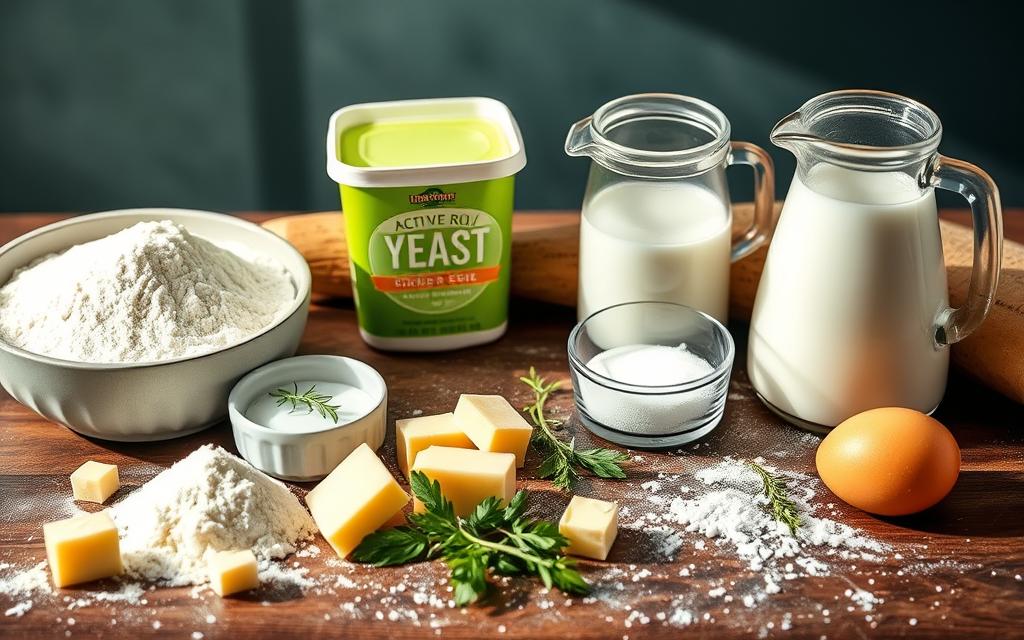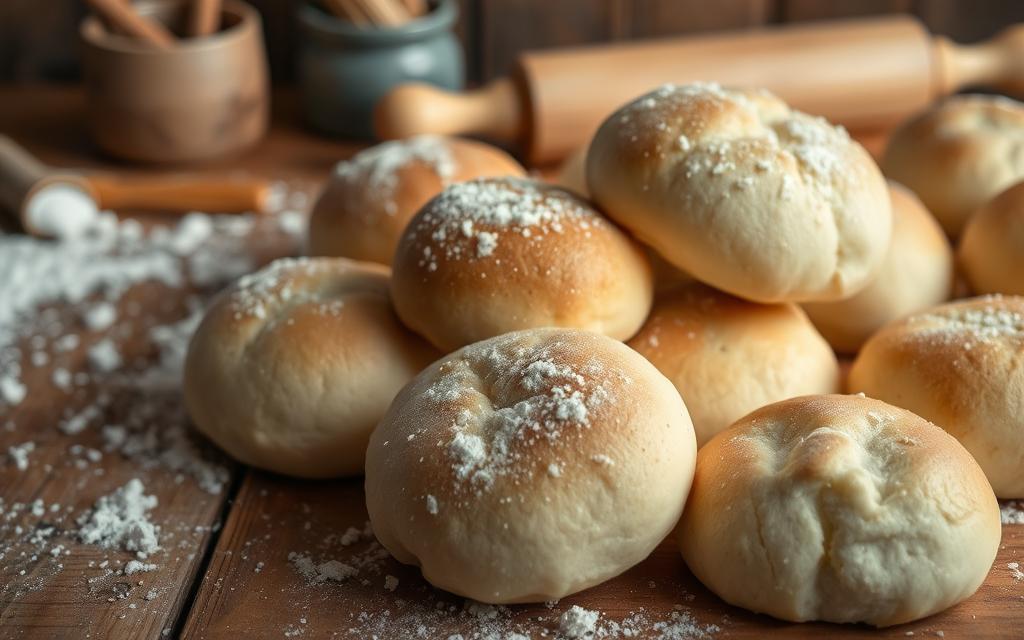Ever wondered why your dinner rolls aren’t light and fluffy? You’re not alone. Troubleshooting dinner rolls can be tough. But knowing the difference between buns and dinner rolls is a good start.
When you ask, “Why are my dinner rolls not light and fluffy?”, think about the ingredients and how they’re made. These factors make buns and dinner rolls unique.
In this article, we’ll explore buns and dinner rolls. We’ll see what makes them special and how to get the right texture. Whether you’re new to baking or experienced, you’ll learn to fix common dinner roll problems.
Introduction to the World of Buns and Dinner Rolls
As you learn about buns and dinner rolls, you’ll see why the right ingredients and techniques matter. By the end, you’ll know how to make your dinner rolls light and fluffy. You’ll be on your way to becoming a skilled baker.
Key Takeaways
- Understanding the difference between buns and dinner rolls is crucial for achieving the perfect texture
- Troubleshooting dinner rolls requires identifying common issues and addressing them with the right techniques
- Using the right ingredients and preparation methods is essential for creating light and fluffy dinner rolls
- Dinner roll issues can be resolved with practice and patience
- Learning about buns and dinner rolls can help you become a better baker
- Achieving the perfect dinner roll texture requires attention to detail and a willingness to experiment
Understanding Buns: Definition and Types
Many people confuse “buns” and “dinner rolls.” But, knowing the difference is key to mastering baking. Let’s dive into what buns are and how they differ from dinner rolls. If you want to get better at baking, making fluffy dinner rolls is a good starting point.
To make dinner rolls fluffier, use the right ingredients and techniques. Soft dinner roll tips include using yeast, flour, and sugar. These ingredients help create a light and airy texture. By following these tips, you can make delicious buns for any occasion.
- Sweet buns, often topped with sugar or cinnamon
- Savory buns, filled with meats or cheeses
- Steamed buns, a popular ingredient in many Asian dishes
Learning about different buns can help you grow as a baker. Whether you aim to make fluffy dinner rolls or improve your baking, understanding buns is a great starting point.
| Type of Bun | Description |
|---|---|
| Sweet Bun | A sweet, fluffy bun often topped with sugar or cinnamon |
| Savory Bun | A savory bun filled with meats or cheeses |
| Steamed Bun | A steamed bun, often used in Asian dishes |
Introduction to Dinner Rolls: Definition and Varieties
Dinner rolls should be light and fluffy, making them great with meals. But, getting them right can be tricky. To make your dinner rolls perfect, it’s key to know the basics and the different types available.
Try out different dinner rolls like butter or garlic ones. They add flavor and contrast to your meals. Also, how you serve dinner rolls can enhance your dining experience. For instance, pair them with soup or your favorite dishes.
- Butter dinner rolls: These rolls are made with butter and are perfect for serving with soups or stews.
- Garlic dinner rolls: These rolls are made with garlic and are great for serving with Italian or Mediterranean dishes.
- Herb dinner rolls: These rolls are made with herbs such as rosemary or thyme and are perfect for serving with roasted meats or vegetables.
By perfecting your dinner roll recipe and trying different varieties, you can create a delicious and memorable dining experience. Whether you’re serving light and fluffy dinner rolls or trying to fix dense dinner rolls, the key is to experiment and find the perfect recipe for your taste preferences.
| Type of Dinner Roll | Ingredients | Serving Suggestions |
|---|---|---|
| Butter Dinner Rolls | Butter, flour, yeast | Soup, stew, salad |
| Garlic Dinner Rolls | Garlic, flour, yeast | Italian dishes, Mediterranean dishes |
| Herb Dinner Rolls | Herbs, flour, yeast | Roasted meats, vegetables |
Key Ingredients: How Buns and Dinner Rolls Differ
Baking buns and dinner rolls requires different ingredients. These ingredients can make or break the texture and taste. If your dinner rolls are dense or dry, it might be because of the ingredients. Knowing how each ingredient works is key to making fluffy dinner rolls.
Fixing dinner roll problems starts with the basics. The flour you choose can change the roll’s texture. Adjusting the flour or sugar can solve many issues. This balance is crucial for making fluffy dinner rolls that everyone will love.

Fixing dinner roll issues often involves the fat content. Changing the fat can make the roll tender and tasty. Here are some tips for troubleshooting dinner rolls:
- Use the right flour for the texture you want.
- Adjust sugar and sweetness to get the flavor right.
- Watch the fat content for the perfect tenderness.
By following these tips, you can make delicious fluffy dinner rolls. Whether you’re new to baking or experienced, mastering dinner rolls is rewarding. With practice, you can fix common dinner roll issues and make rolls that everyone will enjoy.
Shape and Size: A Visual Distinction
Buns and dinner rolls look very different. Their shape and size are key to telling them apart. To make dinner rolls look good, focus on their texture. Use the right flour and don’t overmix the dough.
Light and fluffy dinner rolls keep their shape well. They are soft and airy. Use a mix of all-purpose and bread flour for this. Bread flour’s protein makes the dough stronger, leading to a softer crumb.
Here are some tips for making dinner rolls look great:
- Use a gentle folding technique to avoid overmixing the dough
- Let the dough rise for a sufficient amount of time to allow for even expansion
- Use a sharp knife or razor blade to create a clean cut on the surface of the roll
Follow these tips to make dinner rolls that taste and look good. The secret to light and fluffy rolls is in their texture. Pay attention to how you mix and shape the dough.
With practice, you can make dinner rolls that impress everyone. They’re perfect for any occasion. Whether it’s a casual get-together or a fancy dinner, your rolls will be a hit.
| Type of Flour | Protein Content | Resulting Crumb |
|---|---|---|
| All-purpose flour | 10-12% | Soft and tender |
| Bread flour | 12-14% | Stronger gluten structure, more tender and fluffy |
Flavor Profiles: What Sets Them Apart?
Flavor profiles are key when it comes to buns and dinner rolls. Understanding these differences can help you perfect your recipe. One common problem is dense dinner rolls. But, you can fix this by tweaking ingredients and cooking methods.
To get a balanced flavor in dinner rolls, think about the flour, sugar, and fat. Savory seasonings can also boost the taste. Buns, on the other hand, often have a savory taste. They might include sesame seeds, poppy seeds, or dried herbs.
Buns: Savory Seasonings and Flavors
Buns come in many flavors, from classic sesame to garlic and herb. The secret to a great bun flavor is finding the right balance. You want to mix savory seasonings with the dough’s sweetness.
Dinner Rolls: Sweet and Buttery Notes
Dinner rolls are known for their sweet and buttery taste. To enhance this, add honey, sugar, or butter to the dough. But, don’t overdo it. Too much sugar can make the rolls too sweet.
Knowing the flavor profiles of buns and dinner rolls helps you make delicious breads. Whether you’re fixing dense dinner rolls or perfecting your recipe, focus on balancing flavors and ingredients. This way, you’ll create a harmonious taste experience.
| Type of Bread | Flavor Profile | Common Ingredients |
|---|---|---|
| Buns | Savory | Sesame seeds, poppy seeds, dried herbs |
| Dinner Rolls | Sweet and Buttery | Honey, sugar, butter |
Cultural Significance: Buns and Dinner Rolls in Traditions
Buns and dinner rolls play a big role in many cultures. To enjoy them fully, learning how to make fluffy dinner rolls is key. It’s also important to know how to improve dinner roll texture. This can make your meals even better.
In many places, buns are a common food, often filled with different things. In Asia, steamed buns are a favorite breakfast. In Europe, they’re a side dish. Dinner rolls are big at holidays like Thanksgiving and Christmas. Making fluffy dinner rolls can add a special touch to your holiday meals.
Buns in Various Cuisines
- Steamed buns in Asian cultures
- Baguettes in French cuisine
- Pretzel buns in German cuisine
Dinner Rolls in Holiday Celebrations
Dinner rolls are a big part of holiday meals. They’re great with butter, jam, or cheese. To make them softer, mix all-purpose flour with whole wheat flour. This adds a nutty taste and a softer texture. These tips can help make your dinner rolls a hit with your guests.

Understanding the cultural value of buns and dinner rolls is rewarding. Whether you’re making fluffy dinner rolls or improving their texture, the fun is in experimenting. With these tips, you’ll create a cozy atmosphere for your guests.
| Type of Roll | Cultural Significance | Tips for Making |
|---|---|---|
| Buns | Staple food in many cuisines | Use a combination of all-purpose flour and whole wheat flour |
| Dinner Rolls | Integral part of holiday celebrations | Try using a variety of toppings, such as butter or jam |
Cooking Methods: Baking Differences Explained
To make light and fluffy dinner rolls, knowing the baking techniques is key. Fixing dense dinner rolls can be tough, but the right steps can lead to great results.
Baking buns and dinner rolls differently affects their taste and texture. Buns get a crispy crust from a short bake at high heat. Dinner rolls, baked longer at lower heat, turn out soft and fluffy.
Baking Techniques for Buns
Buns are baked at 400°F (200°C) for 12-15 minutes. This method gives them a crispy outside and a soft inside.
Dinner Roll Preparation Methods
Dinner rolls are baked at 350°F (180°C) for 20-25 minutes. This method makes them light and fluffy, ideal for any meal.
Knowing how to bake buns and dinner rolls differently is crucial. It helps in making perfect dinner rolls, whether fixing dense ones or aiming for light and fluffy ones.
| Baking Technique | Buns | Dinner Rolls |
|---|---|---|
| Temperature | 400°F (200°C) | 350°F (180°C) |
| Baking Time | 12-15 minutes | 20-25 minutes |
When to Use Buns vs. Dinner Rolls
Choosing between buns and dinner rolls depends on the occasion. You want the right bread to match your meal and impress guests. Whether it’s a formal event or a casual get-together, knowing the difference can help.
For a dinner roll issues like dryness, think about your meal. A crusty bun goes well with stews or roasts. For salads or soups, a soft dinner roll is better.
Having troubleshooting dinner rolls problems? Use a good recipe and quality ingredients. Learning to make how to make fluffy dinner rolls can elevate any meal. With practice, you’ll master baking tender dinner rolls.
Here are some tips for choosing between buns and dinner rolls:
- Think about the meal and flavor you want.
- Consider the texture you prefer, soft or crusty.
- Experiment with recipes and ingredients to find your favorite.
Ideal Occasions for Buns
Buns are great for casual events like picnics or barbecues. They’re also good with hearty meals like stews or chili.
Perfect Moments for Serving Dinner Rolls
Dinner rolls are perfect for formal events like weddings or holiday dinners. They impress with their softness. They’re also great with lighter meals like salads or soups.
| Occasion | Bun or Dinner Roll |
|---|---|
| Casual gathering | Bun |
| Formal event | Dinner roll |
| Hearty meal | Bun |
| Lighter meal | Dinner roll |
Conclusion: Choosing the Right Bread for Your Meal
Buns and dinner rolls may look alike, but they are different. They have unique ingredients, shapes, sizes, flavors, and meanings. Think about the event and the mood you want to create when picking your bread.
Summary of Key Differences
Buns are savory, firmer, and bigger. They’re great for burgers or sandwiches. Dinner rolls, though, are smaller, softer, and sweeter. They’re perfect for a big meal or a holiday table.
Final Thoughts on Buns and Dinner Rolls
Choosing between buns and dinner rolls can make your meal better. Whether you’re making soft dinner rolls or improving their texture, it’s all about the experience. Knowing the differences helps you pick the best bread for your meal. This way, you’ll wow your guests with a memorable dining experience.

